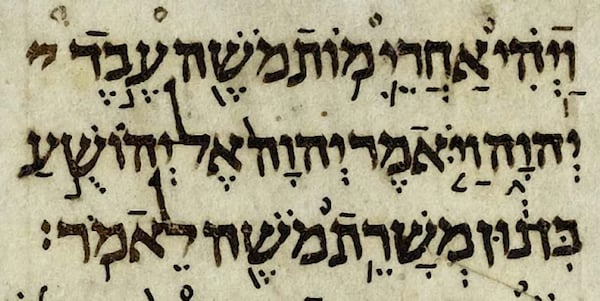9 Surprising Facts About the Hebrew Language
How much do you know about Hebrew? If you’re like most English speakers, not much. Indeed, the Hebrew language has found its way into our collective lexicon with certain phrases like “shalom” and “mazel tov”, but unless you’ve studied it, chances are your knowledge of Hebrew ends there. For instance, did you know that the Hebrew alphabet has no vowels? Or that the language had no speakers for a 1500-year dormant period? Here, we’ve put together some fun and unusual facts about Hebrew to expand your knowledge of this historically rich language.
 Image via idobi / Wikipedia
Image via idobi / Wikipedia
1. There’s no way to say “to be”.
The Hebrew language does not have a verb that translates to “to be”; rather, in sentences that would use “to be” in English, there is no verb at all. For instance, אני פה (“I am here”) consists of just two words: אני (I) and פה (here).
2. It’s one of the original languages of the Bible.
Most scholars agree that the Bible was originally written in three languages: Hebrew, Aramaic, and Greek.
3. Men and women use different verbs.
Verbs take distinct forms depending on whether the subject of the sentence is male or female. A man, for example, might say אני לא מבין (“ani lo mevin”, or “I don’t understand), whereas a woman would say אני לא מבינה (“ani lo mevina”), which means the same thing.
4. The Hebrew alphabet has no vowels.
There are 22 letters in the Hebrew alphabet, and all of them are consonants. Therefore, in standard written Hebrew, the vowels are implicit. However, in children’s books and texts designed for learners, vowels are added to words in the form of small dots that appear above and below each consonant, as in the picture below.
 Image via Wikipedia
Image via Wikipedia
5. Hebrew went through a dormant period of over 1500 years.
Around 200 AD, Hebrew died out as an everyday spoken language, even though it had existed for many centuries before. It remained dormant for over 1500 years until it was revived in the 19th century. During this dormant period, Hebrew still existed in its written form, and was used in Jewish liturgy and rabbinic texts.
6. Hebrew is regulated by an official academy.
Many languages, such as Spanish and French, are regulated by official academies, which provide guidelines for grammar and control which words are added to the dictionary. Hebrew is regulated by the Academy of the Hebrew Language, which was established by the Israeli government in 1953.
7. There’s no way of saying “I would like”.
Politeness is a top concern for many foreign-language learners. If you want to ask for something in Hebrew, however, there’s no way to say that you “would like” something. Instead, you have to be direct, and say that you want something (using the verb רוצה, “rotseh”).
How good is your Hebrew? Find out by taking our free online Hebrew level test!
8. Hebrew letters can change depending on their location in a word.
Five Hebrew letters — צ ,פ ,נ ,מ and כ — have two forms. They appear as written previously when they occur in the beginning or middle of a word. However, the same letters are written as ץ ,ף ,ן ,ם and ך when they come at the end of a word.
9. Hebrew is written from right to left.
Okay, you might have already known this one: unlike most languages, which are written from left to right, Hebrew is written from right to left. But do you know why? Nobody is sure, but a popular theory is that writing from right to left was easier for engravers when they were chiseling words onto stone tablets. These engravers would hold the hammer in their stronger hand (typically their right hand), making it easier to write from right to left.
Now, in addition to shouting “mazel tov” at a party, you can talk about the unique history of the Hebrew language, and expound on theories as to why it’s written the way it is.
The information on this list is just the tip of the iceberg; there’s a lot more you can learn about Hebrew. If you want to learn the language and connect with the 9 million native Hebrew speakers around the world, think about taking Hebrew lessons taught by a qualified native speaker. Send us a quick inquiry to learn more about our Hebrew courses and package options.


